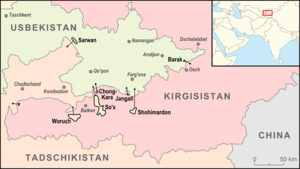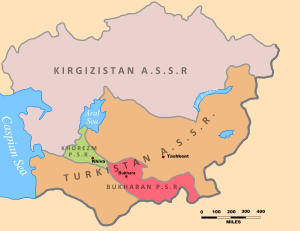Tajikistan–Uzbekistan border
This article's lead section may be too short to adequately summarize the key points. (November 2018) |

The Tajikistan–Uzbekistan border is an international border between Tajikistan and Uzbekistan. It is 1,312 kilometres (815 mi) in length and runs from the tripoint with Kyrgyzstan to the tripoint with Afghanistan.[1]
Description
The border starts in the north at the tripoint with Kyrgyzstan, proceeding west, north-west, north-east along the
Enclaves

There is one enclave along this border, Sarvan, a long, thin piece of Tajik territory lying within Uzbekistan, north of the Tajik town of Punuk.
History
Russia had conquered Central Asia in the 19th century by annexing the formerly independent Khanates of Kokand and Khiva and the Emirate of Bukhara. After the Communists took power in 1917 and created the Soviet Union it was decided to divide Central Asia into ethnically-based republics in a process known as National Territorial Delimitation (or NTD). This was in line with Communist theory that nationalism was a necessary step on the path towards an eventually communist society, and Joseph Stalin's definition of a nation as being “a historically constituted, stable community of people, formed on the basis of a common language, territory, economic life, and psychological make-up manifested in a common culture”.
The NTD is commonly portrayed as being nothing more than a cynical exercise in divide and rule, a deliberately Machiavellian attempt by Stalin to maintain Soviet hegemony over the region by artificially dividing its inhabitants into separate nations and with borders deliberately drawn so as to leave minorities within each state.[2] Though indeed the Soviets were concerned at the possible threat of pan-Turkic nationalism,[3] as expressed for example with the Basmachi movement of the 1920s, closer analysis informed by the primary sources paints a much more nuanced picture than is commonly presented.[4][5][6]
The Soviets aimed to create ethnically homogeneous republics, however many areas were ethnically-mixed (e.g. the

NTD of the area along ethnic lines had been proposed as early as 1920.
On 25 February 1924 the Politburo and Central Committee of the Soviet Union announced that it would proceed with NTD in Central Asia.[15][16] The process was to be overseen by a Special Committee of the Central Asian Bureau, with three sub-committees for each of what were deemed to be the main nationalities of the region (Kazakhs, Turkmen and Uzbeks), with work then exceedingly rapidly.[17][18][19][20][21] There were initial plans to possibly keep the Khorezm and Bukhara PSRs, however it was eventually decided to partition them in April 1924, over the often vocal opposition of their Communist Parties (the Khorezm Communists in particular were reluctant to destroy their PSR and had to be strong-armed into voting for their own dissolution in July of that year).[22]
Of all the Central Asian borders, that between what would later become Tajikistan and Uzbekistan proved the most complex and divisive. Populations here were extremely mixed, and there was a weak sense of Tajik/Uzbek identity in many areas, with many instead identifying as
Over the following years it appears that Tajik nationalism developed, especially amongst the small elite of Tajik Communists., later renamed Stalinabad.
The boundary became an international frontier in 1991 following the dissolution of the Soviet Union and the independence of its constituent republics. Tensions since then have been high, with several high-level Tajik politicians asserting the traditional claim to Bukhara and Samarkand, and Uzbek politicians asserting their right to protect Uzbeks living in Tajikistan.[35][36] Uzbekistan accused Tajikistan of allowing the Islamic Movement of Uzbekistan (IMU) to base itself in its territory; following the 1999 Tashkent bombings, said by Tashkent to be the work of the IMU, Uzbekistan began unilaterally demarcating and mining the border.[35] Relations between the two states have markedly improved since the death of Uzbek President Islam Karimov in 2016; new president Shavkat Mirziyoyev has vowed to improve relations with Tajikistan, and there have been recent high-level moves to de-mine the border and improve cross-border travel.[37][38]
Border crossings
- Beshariq (UZB) - Konibodom (TJK) (road and rail)[39]
- Pap (UZB) – Novbunyod (TJK) (road, bilateral only)[39]
- Oybek (UZB) – Buston (TJK) (road)[39]
- Bekabad (UZB) – Kushtegirmon (TJK) (road, bilateral only, and rail)[39]
- UZB – Zafarobod District (TJK) (possibly several bilateral crossings here, precise details unknown)[39]
- Jartepa (UZB) – Sarazm (TJK) (road)[39]
- Denov (UZB) – Tursunzoda (TJK) (road and rail)[39]
- Gulbahor (UZB) – Shahrtuz (TJK) (road and rail)[39]
Settlements near the border
Tajikistan
- Lakkon
- Kulkent
- Navgilem
- Isfara
- Konibodom
- Punuk
- Jarbulak
- Paldorak
- Buston
- Mastchoh
- Kuruksoi
- Obburdon
- Farmonkurgon
- Zafarobod
- Mehnatobod
- Istaravshan
- Shahriston
- Panjakent
- Farob
- Pakhtaobod
- Tursunzoda
Uzbekistan
See also
References
- ^ CIA World Factbook - Uzbekistan, 23 September 2018
- ^ The charge is so common as to have become almost the conventional wisdom within mainstream journalistic coverage of Central Asia, with Stalin himself often the one drawing the borders, see for example Stourton, E. in The Guardian, 2010 Kyrgyzstan: Stalin's deadly legacy https://www.theguardian.com/commentisfree/2010/jun/20/kyrgyzstan-stalins-deadly-legacy; Zeihan, P. for Stratfor, 2010 The Kyrgyzstan Crisis and the Russian Dilemma https://worldview.stratfor.com/article/kyrgyzstan-crisis-and-russian-dilemma; The Economist, 2010 Kyrgyzstan - Stalin's Harvest https://www.economist.com/briefing/2010/06/17/stalins-harvest?story_id=16377083; Pillalamarri, A in the Diplomat, 2016, The Tajik Tragedy of Uzbekistan https://thediplomat.com/2016/09/the-tajik-tragedy-of-uzbekistan/; Rashid, A in the New York Review of Books, 2010, Tajikistan - the Next Jihadi Stronghold? https://www.nybooks.com/daily/2010/11/29/tajikistan-next-jihadi-stronghold; Schreck, C. in The National, 2010, Stalin at core of Kyrgyzstan carnage, https://www.thenational.ae/world/asia/stalin-at-core-of-kyrgyzstan-carnage-1.548241
- ^ Bergne, Paul (2007) The Birth of Tajikistan: National Identity and the Origins of the Republic, IB Taurus & Co Ltd, pg. 39–40
- ^ Haugen, Arne (2003) The Establishment of National Republics in Central Asia, Palgrave Macmillan, pg. 24–5, 182–3
- ^ Khalid, Adeeb (2015) Making Uzbekistan: Nation, Empire, and Revolution in the Early USSR, Cornell University Press, pg. 13
- ^ Edgar, Adrienne Lynn (2004) Tribal Nation: The Making Of Soviet Turkmenistan, Princeton University Press, pg. 46
- ^ a b Bergne, Paul (2007) The Birth of Tajikistan: National Identity and the Origins of the Republic, IB Taurus & Co Ltd, pg. 44–5
- ^ Edgar, Adrienne Lynn (2004) Tribal Nation: The Making Of Soviet Turkmenistan, Princeton University Press, pg. 47
- ^ Edgar, Adrienne Lynn (2004) Tribal Nation: The Making Of Soviet Turkmenistan, Princeton University Press, pg. 53
- ^ Bergne, Paul (2007) The Birth of Tajikistan: National Identity and the Origins of the Republic, IB Taurus & Co Ltd, pg. 43–4
- ^ Starr, S. Frederick (ed.) (2011) Ferghana Valley – the Heart of Central Asia Routledge, pg. 112
- ^ Bergne, Paul (2007) The Birth of Tajikistan: National Identity and the Origins of the Republic, IB Taurus & Co Ltd, pg. 40–1
- ^ Starr, S. Frederick (ed.) (2011) Ferghana Valley – the Heart of Central Asia Routledge, pg. 105
- ^ Bergne, Paul (2007) The Birth of Tajikistan: National Identity and the Origins of the Republic, IB Taurus & Co Ltd, pg. 39
- ^ Edgar, Adrienne Lynn (2004) Tribal Nation: The Making Of Soviet Turkmenistan, Princeton University Press, pg. 55
- ^ Bergne, Paul (2007) The Birth of Tajikistan: National Identity and the Origins of the Republic, IB Taurus & Co Ltd, pg. 42
- ^ Edgar, Adrienne Lynn (2004) Tribal Nation: The Making Of Soviet Turkmenistan, Princeton University Press, pg. 54
- ^ Edgar, Adrienne Lynn (2004) Tribal Nation: The Making Of Soviet Turkmenistan, Princeton University Press, pg. 52–3
- ^ Bergne, Paul (2007) The Birth of Tajikistan: National Identity and the Origins of the Republic, IB Taurus & Co Ltd, pg. 92
- ^ Starr, S. Frederick (ed.) (2011) Ferghana Valley – the Heart of Central Asia Routledge, pg. 106
- ^ Khalid, Adeeb (2015) Making Uzbekistan: Nation, Empire, and Revolution in the Early USSR, Cornell University Press, pg. 271–2
- ^ Edgar, Adrienne Lynn (2004) Tribal Nation: The Making Of Soviet Turkmenistan, Princeton University Press, pg. 56–8
- ^ Haugen, Arne (2003) The Establishment of National Republics in Central Asia, Palgrave Macmillan, pg. 33–41
- ^ Haugen, Arne (2003) The Establishment of National Republics in Central Asia, Palgrave Macmillan, pg. 153
- ^ Bergne, Paul (2007) The Birth of Tajikistan: National Identity and the Origins of the Republic, IB Taurus & Co Ltd, pg. 102
- ^ Bergne, Paul (2007) The Birth of Tajikistan: National Identity and the Origins of the Republic, IB Taurus & Co Ltd, pgs, 51–2
- ^ a b Starr, S. Frederick (ed.) (2011) Ferghana Valley – the Heart of Central Asia Routledge, pg. 113
- ^ Khalid, Adeeb (2015) Making Uzbekistan: Nation, Empire, and Revolution in the Early USSR, Cornell University Press, pg. 368
- ^ Haugen, Arne (2003) The Establishment of National Republics in Central Asia, Palgrave Macmillan, pg. 149
- ^ Bergne, Paul (2007) The Birth of Tajikistan: National Identity and the Origins of the Republic, IB Taurus & Co Ltd, pg. 112
- ^ Haugen, Arne (2003) The Establishment of National Republics in Central Asia, Palgrave Macmillan, pg. 154
- ^ Bergne, Paul (2007) The Birth of Tajikistan: National Identity and the Origins of the Republic, IB Taurus & Co Ltd, pg. 55
- ^ Rahim Masov, The History of the Clumsy Delimitation, Irfon Publ. House, Dushanbe, 1991 (in Russian). English translation: The History of a National Catastrophe, transl. Iraj Bashiri, 1996
- ^ Bergne, Paul (2007) The Birth of Tajikistan: National Identity and the Origins of the Republic, IB Taurus & Co Ltd, pg. 119
- ^ a b Trofimov, Dmitriy (2002), Ethnic/Territorial and Border Problems in Central Asia, retrieved 28 October 2018
- ^ International Crisis Group (4 April 2002), CENTRAL ASIA – BORDER DISPUTES AND CONFLICT POTENTIAL (PDF), retrieved 28 October 2018
- ^ Najibullah, Farangis (15 March 2018), 'Counting The Days': Tajiks, Uzbeks Have Great Expectations After Landmark Border Deals, retrieved 4 November 2018
- ^ The Defense Post (17 April 2018), Tajikistan and Uzbekistan to study and schedule border demining, retrieved 4 November 2018
- ^ a b c d e f g h Caravanistan – Uzbekistan border crossings, retrieved 7 October 2018
